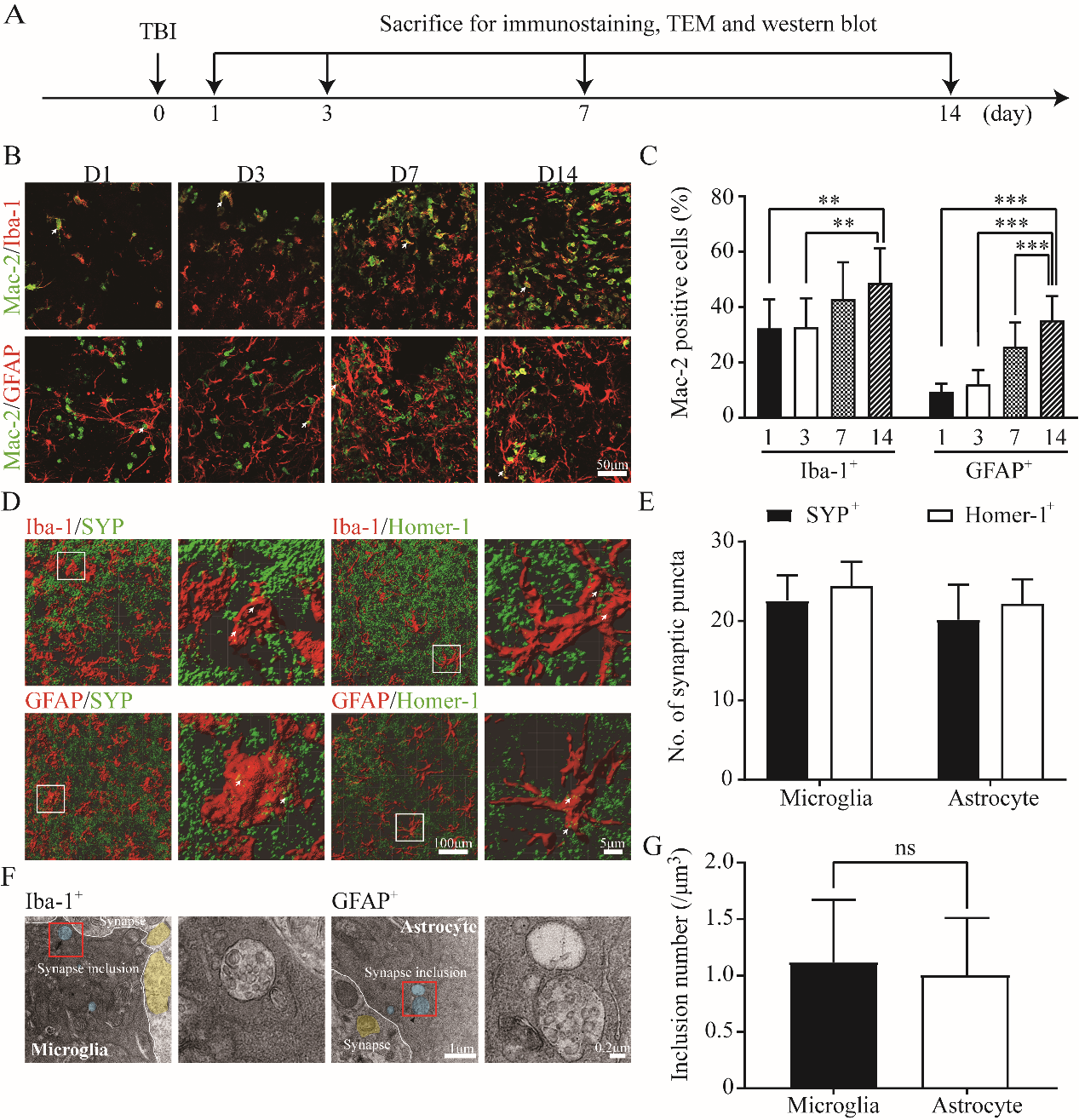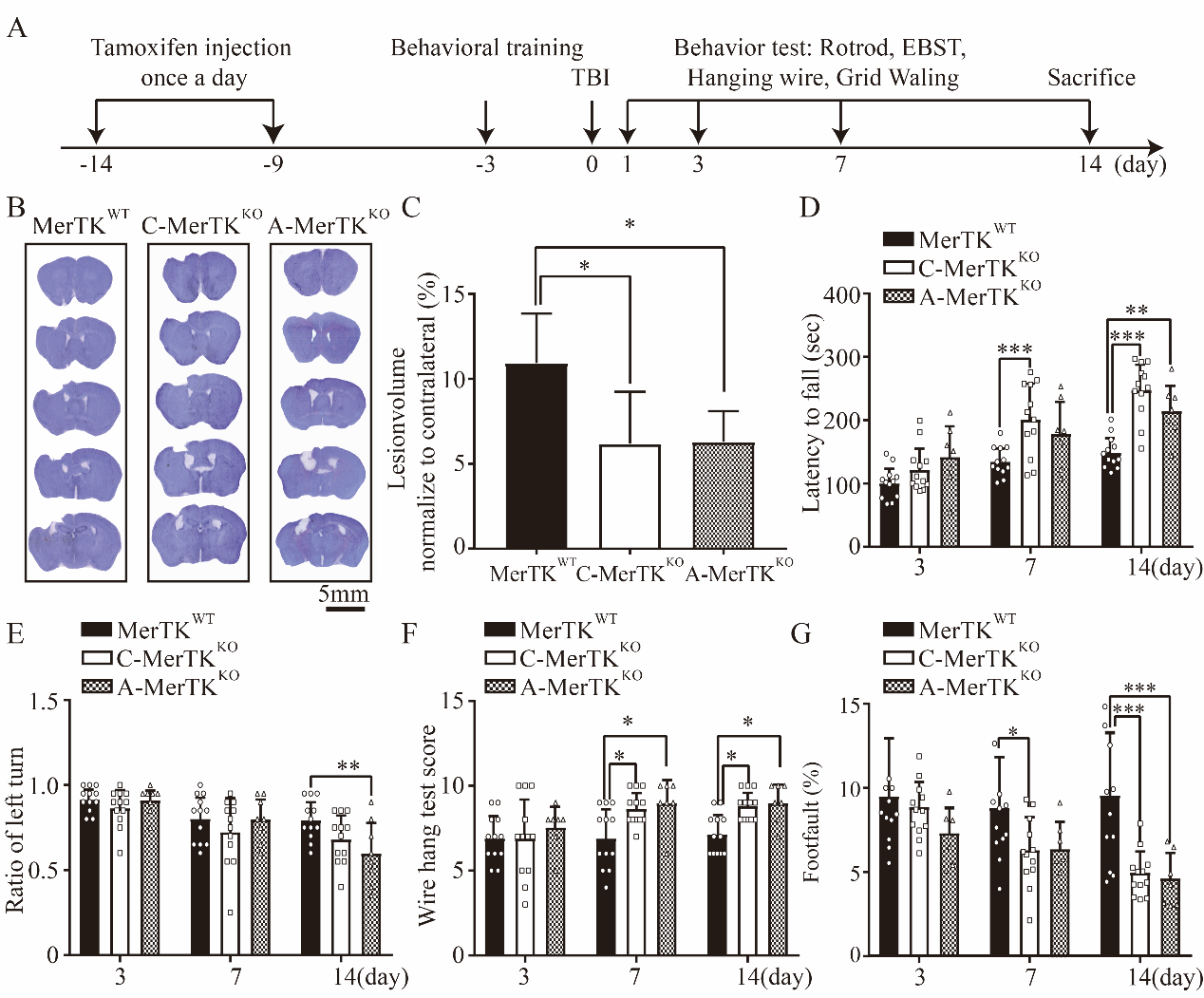NRR:上交杨国源团队提出抑制胶质细胞吞噬可减少创伤性脑损伤后的突触缺失
撰文:沈辉
创伤性脑损伤后,胶质细胞会快速激活。在损伤急性期,胶质细胞可清除死细胞和细胞碎片,减轻炎症反应[1]。越来越多的证据表明,小胶质细胞和星形胶质细胞也会在修复期吞噬正常神经元和神经突触,以阻碍神经功能的修复。在发育或者脑卒中等模型中,已有报道称,胶质细胞和星形胶质细胞可通过MER原癌激酶(MER proto-oncogene tyrosine kinase,MERTK)介导突触吞噬[2-4]。此外,小胶质细胞和星形胶质细胞在脑缺血中的吞噬能力存在时空差异,这暗示了其在吞噬中发挥了不同的作用[5]。然而在创伤性脑损伤之中,胶质细胞介导的吞噬作用对于创伤性脑损伤神经功能的影响以及小胶质细胞和星形胶质细胞吞噬功能的差异对神经功能恢复的是否存在不同的影响,目前尚不明确。因此研究创伤性脑损伤后胶质细胞介导的吞噬,可以更好的理解突触丢失的可能机制,并以此研发出更好的临床治疗手段。
最近,来自中国上海交通大学杨国源团队在《中国神经再生研究(英文版)》(Neural Regeneration Research)上发表了题为“Microglia and astrocytes mediate synapse engulfment in a MER tyrosine kinase-dependent manner after traumatic brain injury” 的文章。该研究发现,创伤性脑损伤后,胶质细胞可快速激活,并显示出吞噬能力,且能上调MERTK的表达。特异性敲除小胶质细胞或星形胶质细胞中的MERTK可抑制突触吞噬,增加轴突数量,并可缩小脑损伤体积,促进神经行为功能的恢复。这一研究表明MERTK在胶质细胞介导的突触吞噬作用中发挥着重要的作用,其可能成为创伤性脑损伤后神经修复的一个潜在的治疗靶点。
创伤性脑损伤后,小胶质细胞和星形胶质细胞会快速激活。为探究激活的小胶质细胞和星形胶质细胞是否具有吞噬性能,以免疫荧光染色观察,可见激活的小胶质细胞和星形胶质细胞在创伤性脑损伤后14d内增多,同时发现小胶质细胞在早期就有较多的激活,而星形胶质细胞则在14d时才展现较多的吞噬特性。同时在创伤性脑损伤后14d时的小鼠大脑小胶质细胞和星形胶质细胞内都发现了突触信号,表明在创伤性脑损伤后14d存在吞噬突触的现象,且小胶质细胞和星形胶质细胞吞噬突触的能力相当(图1)。此前已有研究证明,MERTK能够介导胶质细胞的吞噬作用,且在发育过程中参与突触修剪的过程。因此为确定特异性抑制小胶质细胞和星形胶质细胞中MERTK基因是否能减少脑损伤体积并改善小鼠的行为功能,对转基因小鼠以及野生型小鼠进行神经行为学检测以及脑组织焦油紫染色。结果表明,无论是在小胶质细胞还是在星形胶质细胞中特异性敲除MERTK都可很好的改善神经行为功能,小鼠在转棒实验、转体实验、网格实验和钢丝悬挂试验中均比对照组有更好的行为改善。同时特异性抑制小胶质细胞和星形胶质细胞中MERTK基因后,小鼠的脑损伤体积也都小于对照组(图2)。这些结果都表明特异性抑制小胶质细胞和星形胶质细胞的吞噬能力,可改善创伤性脑损伤小鼠的预后。

图1创伤性脑损伤后胶质细胞可快速激活并吞噬突触。(图源:Shen et al., Neural Regen Res, 2023)

图2胶质细胞上特异性抑制MERTK可缩小创伤性脑损伤后脑损伤体积并改善神经行为功能。(图源:Shen et al., Neural Regen Res, 2023)
为进一步探究特异性抑制小胶质细胞和星形胶质细胞中MERTK基因是如何影响创伤性脑损伤小鼠预后的,创伤性脑损伤后14d时以免疫荧光染色、电镜表征以及免疫蛋白印迹方法检测发现,小胶质细胞和星形胶质细胞在敲除MERTK后均能减少突触的吞噬,且增加损伤区域中突触蛋白水平。这些结果表明,通过特异性抑制小胶质细胞和星形胶质细胞中MERTK,可抑制吞噬突触能力,从而改善预后(图3)。最后通过高尔基染色方法观察了创伤性脑损伤后皮质树突棘的结构与密度,结果显示,特异性敲除MERTK可增加突触总数以及成熟树突棘的数量(图4)。

图3胶质细胞上特异性抑制MERTK可减少创伤性脑损伤后突触吞噬并增加突触蛋白含量。(图源:Shen et al., Neural Regen Res, 2023)

图4胶质细胞上特异性抑制MERTK可以增加创伤性脑损伤后突触密度。(图源:Shen et al., Neural Regen Res, 2023)总之,抑制小胶质细胞和星形胶质细胞介导的突触吞噬,可有效减少突触缺失。这项研究表明,MERTK在创伤性脑损伤后突触吞噬过程中起到重要的作用。特异性抑制MERTK可促进神经功能的恢复。该结果对创伤性脑损伤后突触缺失的治疗提供了新的策略。
该研究只针对创伤性脑损伤后14d的突触吞噬,为进一步分析疾病的发生发展,未来可考虑观察其他时间点的变化。此外为观察性别特异性,也应考虑使用雌性小鼠进行实验,以对比不同性别在突触缺失方面的差异。最后,虽然已经确定了小胶质细胞和星形胶质细胞的突触吞噬是通过MERTK来介导的,但其之后的信号通路尚未完全阐明,这也是未来研究的方向之一。
#br#
原文链接:https://doi.org/10.4103/1673-5374.363187#br#
#br#
#br#
参考文献#br#
[1] Zhou H, Hu L, Li J, et al. AXL kinase-mediated astrocytic phagocytosis modulates outcomes of traumatic brain injury. J Neuroinflammation. 2021;18(1):154.#br#
[2] Neher JJ, Emmrich JV, Fricker M, et al. Phagocytosis executes delayed neuronal death after focal brain ischemia. Proc Natl Acad Sci U S A. 2013;110(43):E4098-4107.#br#
[3] Bellesi M, De Vivo L, Chini M, et al. Sleep loss promotes astrocytic phagocytosis and microglial activation in mouse cerebral cortex. J Neurosci. 2017;37(21):5263-5273.#br#
[4] Cahoy JD, Emery B, Kaushal A, et al. A transcriptome database for astrocytes, neurons, and oligodendrocytes: a new resource for understanding brain development and function. J Neurosci. 2008;28(1):264-278.#br#
[5] Morizawa YM, Hirayama Y, Ohno N, et al. Reactive astrocytes function as phagocytes after brain ischemia via ABCA1-mediated pathway. Nat Commun. 2017;8(1):28.#br#
#br#
 #br#
杨国源实验室
#br#
杨国源实验室
沈辉为论文第一作者,杨国源教授为论文通讯作者。作者所在团队主要研究脑血管疾病的发病机制和临床基础研究,研究方向包括:1)神经血管网络;2)脑缺血的发病机制和干预;3)动静脉畸形的发病机制和干预;4)神经影像学在脑缺血研究中的应用;5)干细胞在脑血管病治疗中临床应用。




 #br#
杨国源实验室
#br#
杨国源实验室